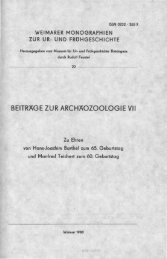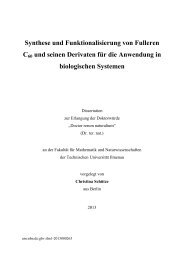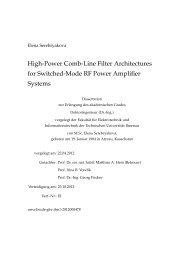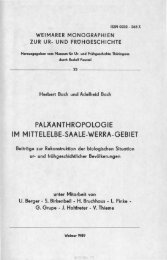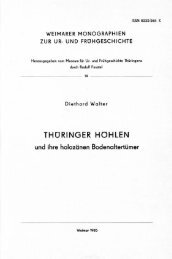Dissertation
Dissertation
Dissertation
You also want an ePaper? Increase the reach of your titles
YUMPU automatically turns print PDFs into web optimized ePapers that Google loves.
|3.2 Bisphenanthroline: A Suitable Molecular Bridge?|<br />
Furthermore, phenphen has no electron storage moiety which compares to the pyrazine moiety of<br />
the tpphz ligand. According to Campagna et al., this results in more negative reduction potentials<br />
for the bridge in [(bpy) 2 M(µ-phenphen)M(bpy) 2 ] 4+ (M = Ru, Os, Ir), when compared to tpphz<br />
complexes. [131]<br />
These two facts, missing electron storage capacity and negative reduction potentials, hold the<br />
potential that a reduction of other metal centers such as Pt(II), Rh(III) or Co(III) would be possible<br />
after excitation of the MLCT in a heteronuclear phenphen-bridged complex.<br />
Thus, the use of phenphen shall be applied in heteronuclear P ∼ B ∼ C-type systems. Leaving<br />
the chromophore unchanged but focusing on the bridging ligand and reaction center allows<br />
characterizing and understanding the nature of charge separation and electron transfer in the<br />
supramolecular catalyst. Therefore, one of the two [Ru(bpy) 3 ]-type centers at the binuclear<br />
phenphen bridged ruthenium complex of Campagna et al. may represent the chromophore<br />
which offers high synthetic flexibility, high stability and well understood photophysical and redox<br />
properties. The second metal center has to be replaced by a variety of reaction centers such as<br />
noble metals Rh, Re, Pd, Pt or other metal centers such as Co or Ni which have been found to be<br />
suitable for different kinds of redox catalysis. [88]<br />
With respect to the resulting P ∼ B ∼ C-system, two major drawbacks were identified until today<br />
which reduce the quantum yield of the overall reaction:<br />
On the one hand, decomplexation processes of the catalyst-systems with possible colloid<br />
formation or chromophore decomposition are side reactions that may occur after photo<br />
reduction.<br />
[94, 132]<br />
On<br />
the other hand, it is difficult but essential to tune the kinetic and<br />
thermodynamic properties of the bridging ligand (e.g. electronic communication/insulation or<br />
electron storage to a greater or lesser extent as previously discussed for the tpphz ligand) because<br />
these factors may potentially limit the type of reducible metal centers and the rate of side reactions<br />
or charge recombination. [80]<br />
In the following section, the synthesis of mononuclear and hetero-dinuclear phenphen-bridged<br />
complexes will be presented. The characterization of the photo- and electrochemical properties<br />
will be discussed toward the application potential within P ∼ phenphen ∼ C-type systems in light<br />
driven catalysis. Special emphasis will be placed on the characterization of stereoisomers.<br />
|84|



